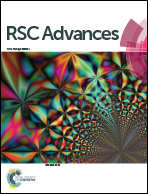Porous Co3O4 nanoparticles derived from a Co(ii)-cyclohexanehexacarboxylate metal–organic framework and used in a supercapacitor with good cycling stability
Abstract
Porous cobalt oxide materials have received great interest in recent years due to their potential application to supercapacitors. In this work, porous Co3O4 nanoparticles were prepared by the thermolysis of a Co(II)-based [Co3(cis-chhc)(H2O)6]n (cis-H6chhc = 1,2,3,4,5,6-cyclohexane-hexacarboxylic acid) metal–organic framework. Cyclic voltammetry and galvanostatic charge–discharge measurements were carried out to characterize the electrochemical performance of Co3O4 in a 2.0 M KOH electrolyte. The results demonstrate that the as-synthesized Co3O4 can be applied as a supercapacitor electrode. The porous Co3O4 electrode exhibits a specific capacitance of 148 F g−1 at a current density of 1 A g−1, and displays slightly enhanced capacitance after 2500 continuous charge–discharge cycles. This remarkable electrochemical performance suggests that the as-prepared porous Co3O4 material is potentially promising for applications in energy storage.


 Please wait while we load your content...
Please wait while we load your content...